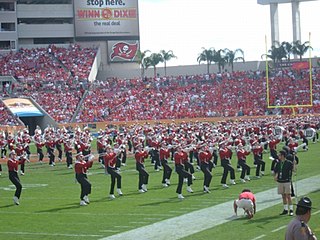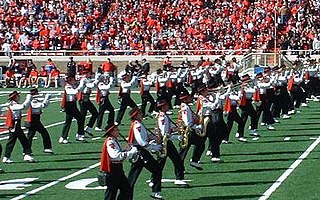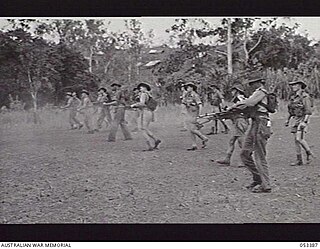 W
WA Broom brigade was a type of military-style women's drill team that marched with brooms instead of rifles. Drilling was a popular form of exercise at the time, when participation in sports was largely restricted to men. They were popular in America during the late 19th century. They were mentioned in Mark Twain's book "Life on the Mississippi".
 W
WThe chair step is a type of high step used by marching bands. This step is named because of the resemblance of the leg in action to a leg's position when sitting in a chair. It is primarily used by bands that brand themselves as traditional-style bands. Nearly all bands in the Big Ten Conference use this style. It is also common in Midwestern high school marching bands, most of which are heavily influenced by Big Ten bands.
 W
WA death march is a forced march of prisoners of war or other captives or deportees in which individuals are left to die along the way. It is distinguished in this way from simple prisoner transport via foot march. Article 19 of the Geneva Convention requires that prisoners must be moved away from a danger zone such as an advancing front line, to a place that may be considered more secure. It is not required to evacuate prisoners that are too unwell or injured to move. In times of war such evacuations can be difficult to carry out.
 W
WDrill commands are generally used with a group that is marching, most often in military foot drill or marching band. Drill commands are usually heard in major events involving service personnel, reservists and veterans of a country's armed forces, and by extension, public security services and youth uniformed organizations.
 W
WA drill team can be one of four different entities:A military drill team is a marching unit that performs routines based on military foot or exhibition drills. Military drill teams perform either armed or unarmed. A dance drill team creates routines based on precision dance movements rather than military drill. These teams usually do not carry anything, but may use props in field production numbers. They may perform to recorded music, or the live music of an accompanying marching band. A team that execute routines carrying either one or multiple flags or pom-poms. This team's movements are also based in dance and may also have a heavy influence of gymnastics as well. These teams also may perform to music, either live or recorded. A team that is mounted or advances some type of mobile object. May also include teams of dogs and handlers.
 W
WFoot drill is a part of the training regimen of organized military and paramilitary elements worldwide. "Foot drill" or "Drill" stems from time since antiquity when soldiers would march into battle, be expected to gather in a formation, and react to words of command from their commanders once the battle commenced. Much of the drill done today is either ceremonial, or implemented as a core part of training in the armed forces. Military discipline is enhanced by drill, as it requires instant obedience to commands and synchronized completion of said commands with the others in the unit.
 W
WThe goose step is a special marching step which is performed during formal military parades and other ceremonies. While marching in parade formation, troops swing their legs in unison off the ground while keeping each leg rigidly straight.
 W
WA loaded march is a relatively fast march over distance carrying a load and is a common military exercise.
 W
WIn the United States, lockstep marching or simply lockstep is marching in a very close single file in such a way that the leg of each person in the file moves in the same way and at the same time as the corresponding leg of the person immediately in front of him, so that their legs stay very close all the time.
 W
WA marching band is a group of instrumental musicians who perform while marching, often for entertainment or competition. Instrumentation typically includes brass, woodwind, and percussion instruments. Most marching bands wear a uniform, often of a military-style, that includes an associated organization's colors, name or symbol. Most high school marching bands, and some college marching bands, are accompanied by a color guard, a group of performers who add a visual interpretation to the music through the use of props, most often flags, rifles, and sabres.
 W
WA marching band is a group of instrumental musicians who perform while marching, often for entertainment or competition. Instrumentation typically includes brass, woodwind, and percussion instruments. Most marching bands wear a uniform, often of a military-style, that includes an associated organization's colors, name or symbol. Most high school marching bands, and some college marching bands, are accompanied by a color guard, a group of performers who add a visual interpretation to the music through the use of props, most often flags, rifles, and sabres.
 W
WMarching fire, also known as walking fire, is a military tactic – a form of suppressive fire used during an infantry assault or combined arms assault. Advancing units fire their weapons without stopping to aim, in an attempt to pin down enemy defenders. Marching fire usually ends with an infantry charge to engage the enemy in close combat. The tactic requires ample ammunition and rapid-fire weapons. It differs from fire and movement in that the attacking force advances in unison rather than leapfrogging forward in alternating groups.
 W
WMarking time is a military step in which soldiers march in place, moving their legs as in marching, but without stepping forward.
 W
WA military parade is a formation of soldiers whose movement is restricted by close-order manoeuvering known as drilling or marching. The military parade is now almost entirely ceremonial, though soldiers from time immemorial up until the late 19th century fought in formation. Massed parades may also hold a role for propaganda purposes, being used to exhibit the apparent military strength of a country.
 W
WMilitary step or march is a regular, ordered and synchronized walking of military formations.
 W
WReverse arms and the related rest on arms reversed are military drill commands used as a mark of respect at funerals and on occasions of mourning, especially in the armed forces of Commonwealth nations. When marching in reverse arms the soldier's weapon is held pointing behind them and grasped behind their back. When resting on reversed arms the weapon points towards the ground and the eyes are lowered.